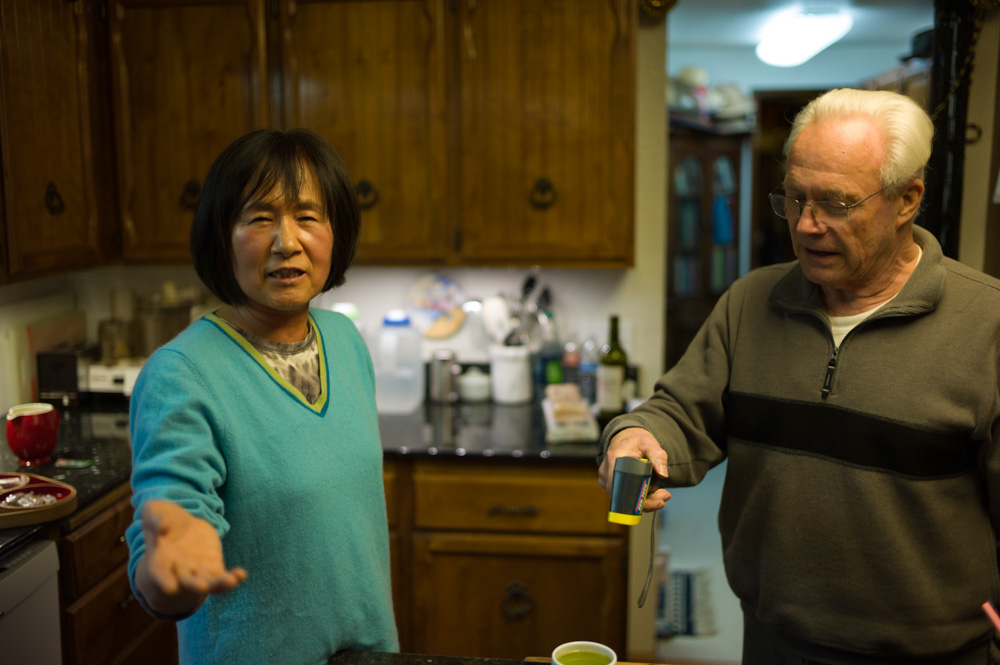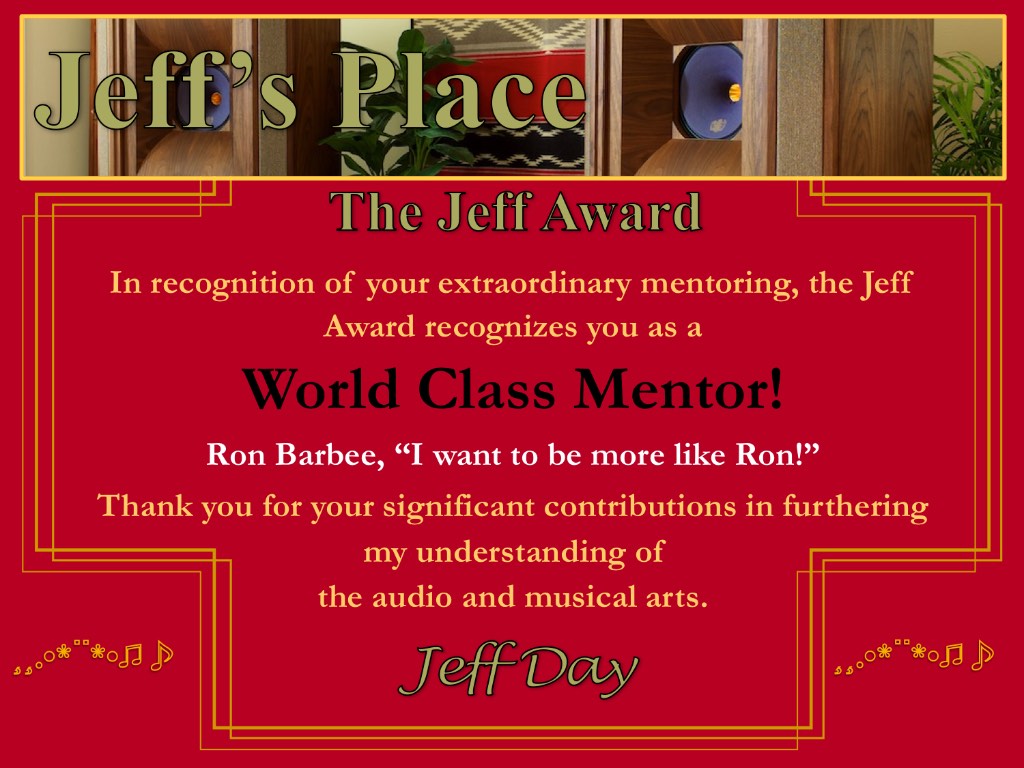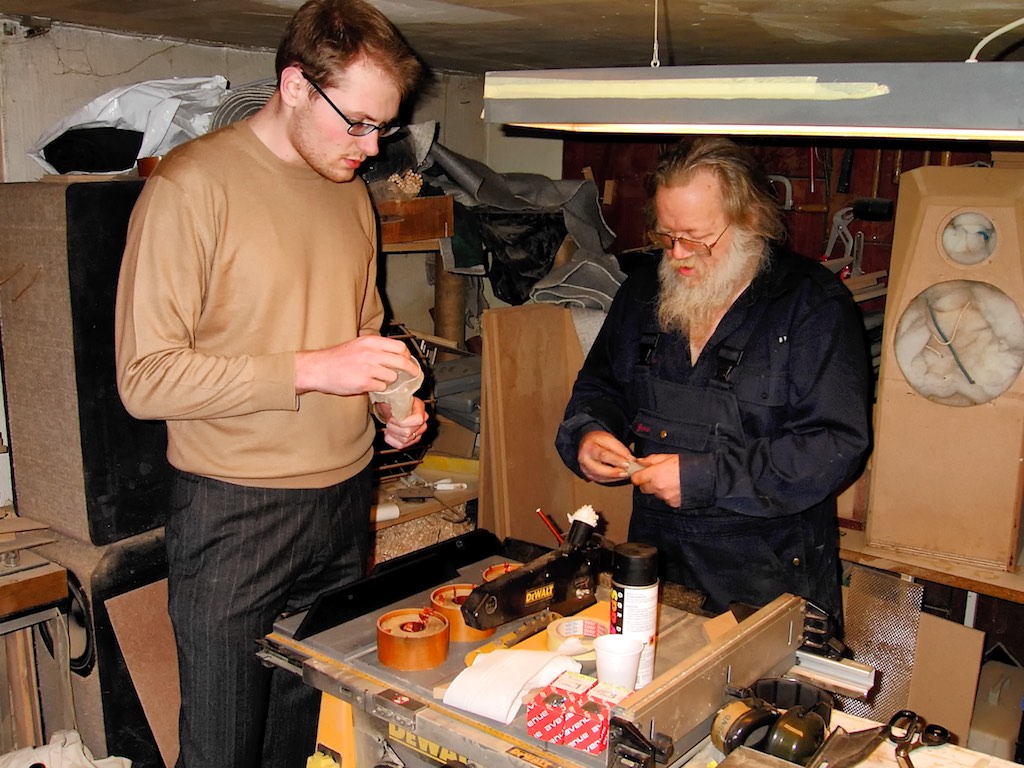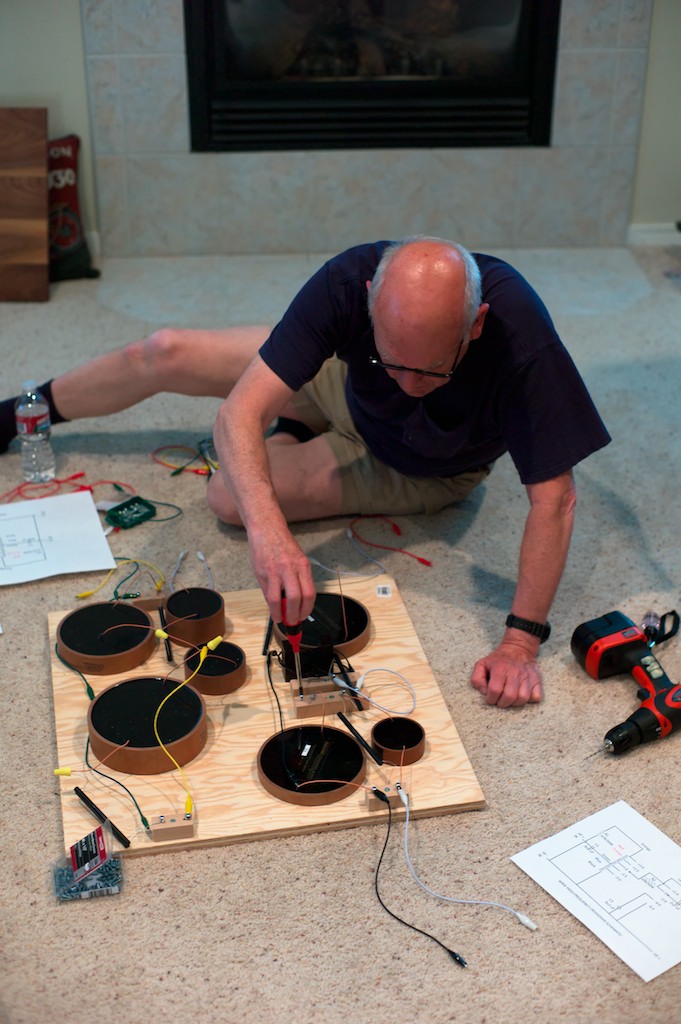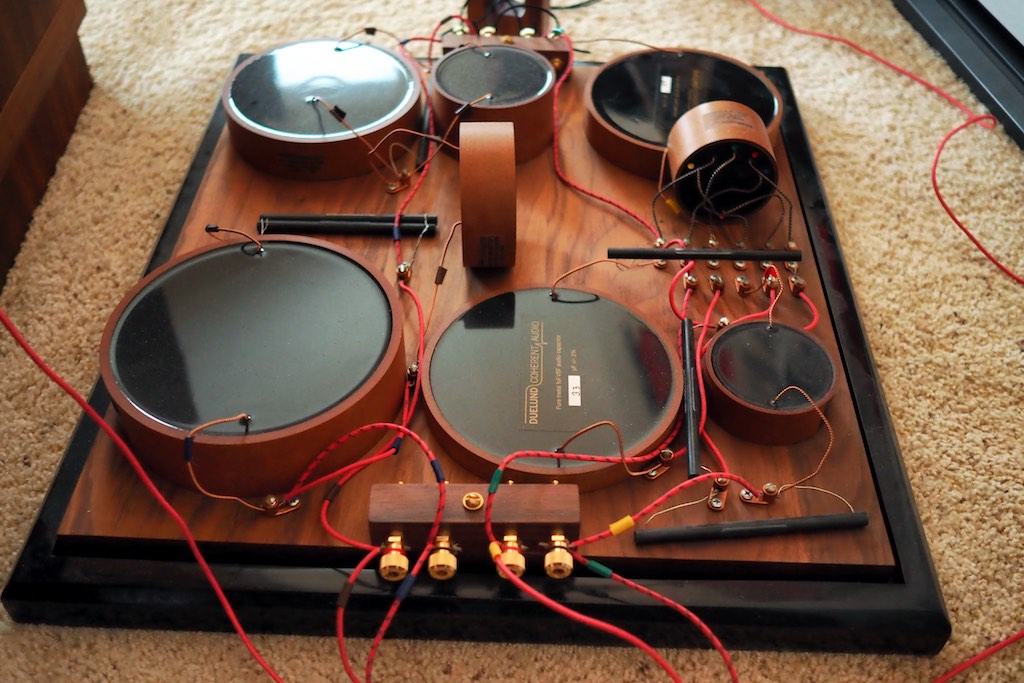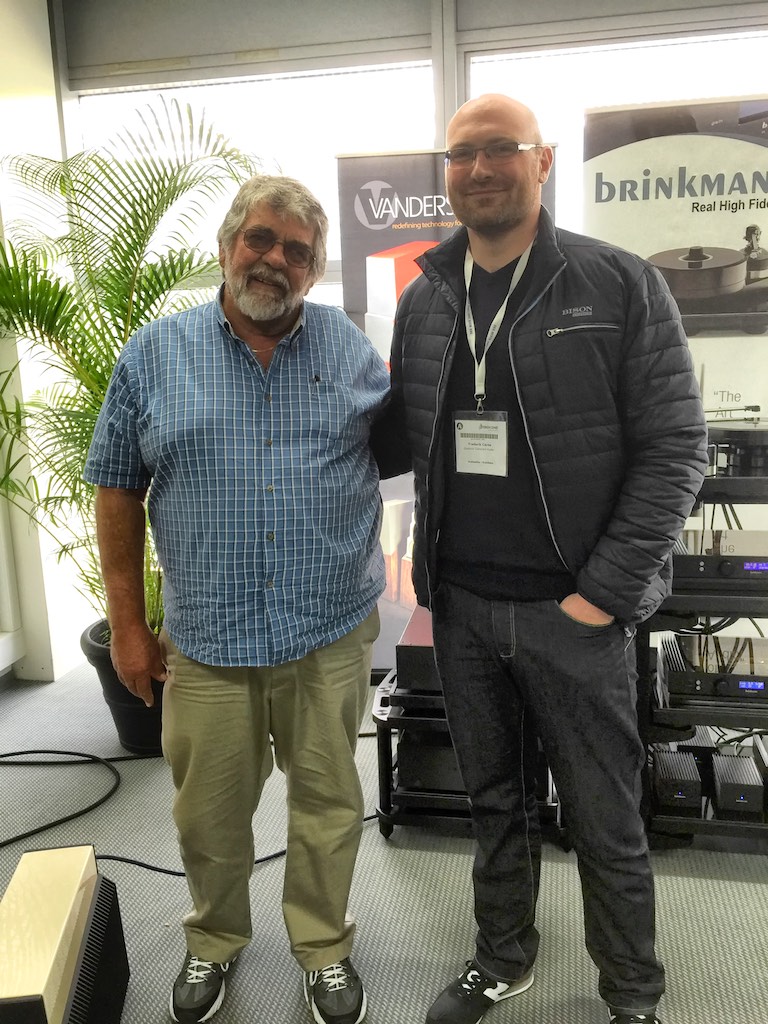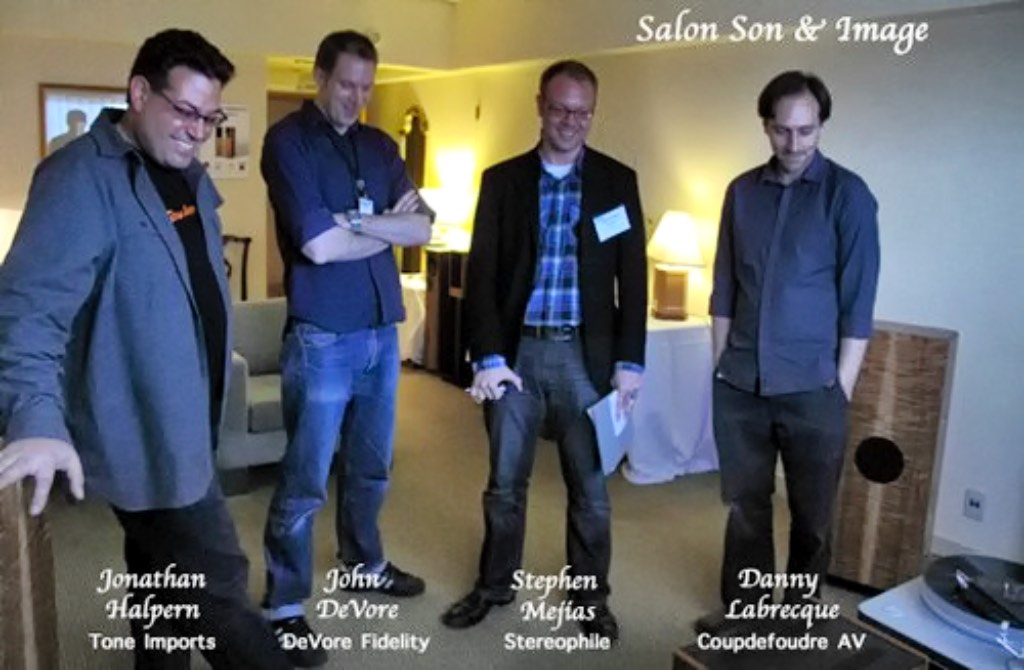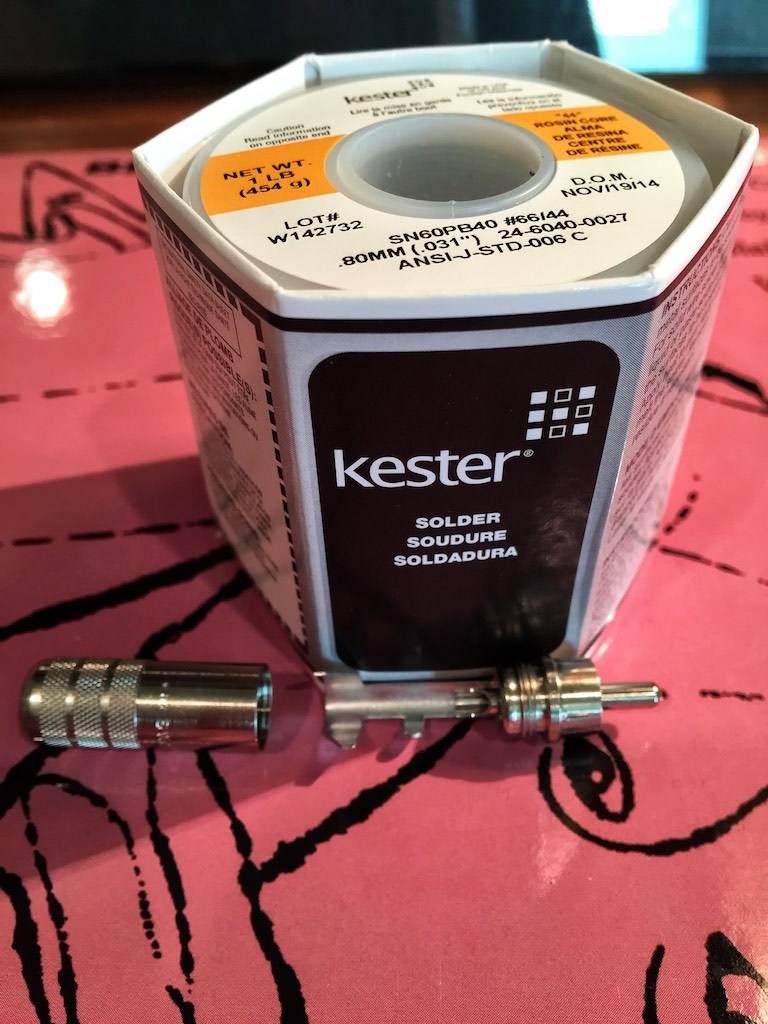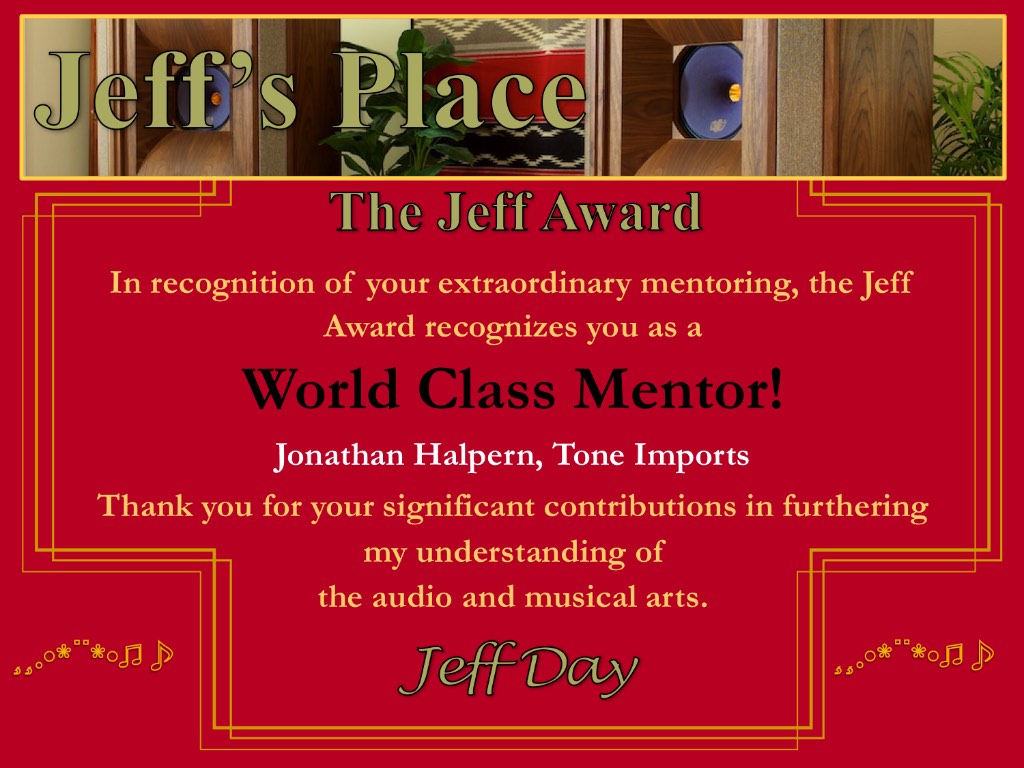I've been reflecting back on my time in the audio hobby a lot lately, and thinking about what a tremendously satisfying hobby it has been on so many levels.
A lot of what is wonderful about this hobby are those individuals that I've met over the years, who together have had such a dramatic influence on my enjoyment and understanding of the musical and audio arts. It takes a village to raise an audio nut!
I sincerely want to thank all of you, I truly appreciate you, and your positive influence on my life and audio adventures! You're the best!
In alphabetical order, the first group of individuals I'd like to express my appreciation to are:
Ron Barbee, "I want to be more like Ron!"
In 2015 I gave my good friend and fellow audio adventurer, Ron Barbee, a Jeff Award for the profound influence he has had on me over the last few years, contributing immensely to both my enjoyment & understanding of the audio & musical arts.
Ron is a life-long audio enthusiast, music lover, musician (guitarist), and has the highly trained mind of a nuclear engineer – he is a true modern day renaissance man.
Ron has a wonderful vintage system in every room in his home, which has truly inspired me, and my mantra for the last year has been “I want to be more like Ron!”
Now, with three out of the four rooms in my home having audio systems in them, I've only got one more room to go!
Ron was involved in the early Japanese audio scene while living in Japan, and that is where he met his wife Sumie-san.
Ron has been building & modifying vacuum tube amplifiers for many years, and has a particular penchant for vintage audio electronics.
It was primarily through Ron's influence that I got interested in vintage audio electronics, due to Ron letting me listen to audio gear from his vintage collection, and I was inspired by the beautiful tone & musicality that seems to come so easily from good vintage gear.
Ron has also taught me an enormous amount about modifying electronics over the last year during our adventures in 'real sound' with Yazaki-san (1), where we hot-rodded my vintage McIntosh MC30 monaural amplifiers, and then later, my vintage McIntosh MX110Z tuner preamplifier.
Through Ron's patient mentoring of me in modifying vintage hi-fi electronics, I have begun to understand how the circuits in vintage hi-fi electronics work, and I have learned how to do simple modifications of my own!
While I'm still very much a novice in modifying electronics, there is a tremendous feeling of liberation and empowerment in knowing that through a few select circuit modifications with capacitors & resistors that it is possible to 'voice' one's electronics to sound exactly the way you want them to in your system.
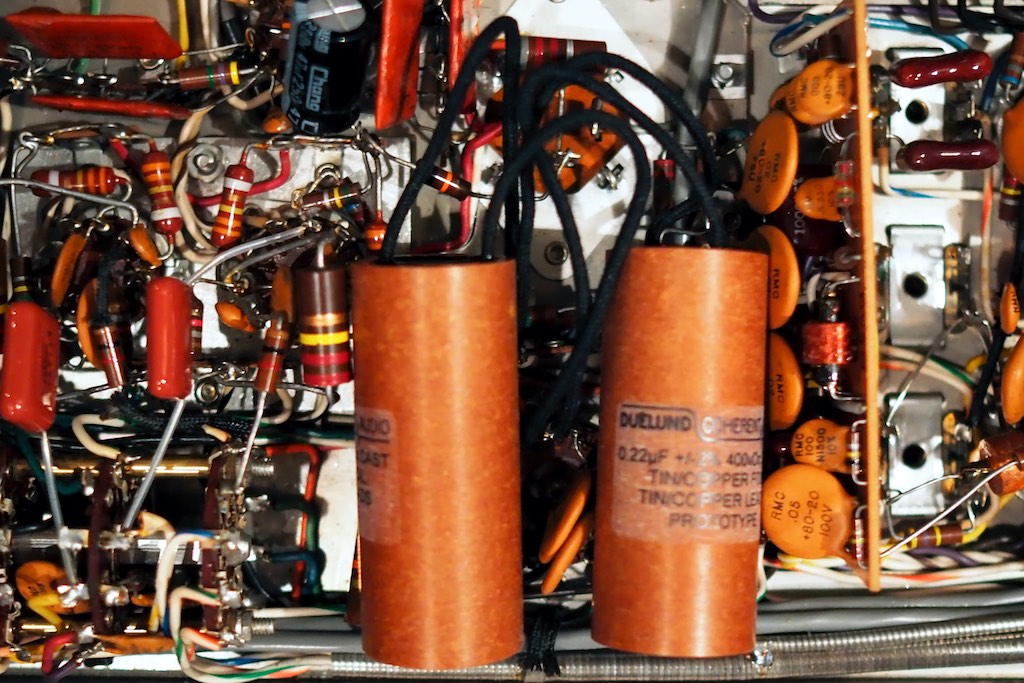
A pair of prototype 0.22uF Duelund CAST Sn-Cu capacitors that I've soldered into my vintage MX110Z McIntosh tuner-preamplifier.
It was an incredible revelation for me to be able to solder in & out capacitors & resistors in a circuit and hear changes in musicality & sonics of a magnitude equal to or greater than changing an entire component, like a power amplifier or preamplifier, in a home music system.
This revelation got me off the audio merry-go-round of buying and changing out new equipment in an attempt to get a musically satisfying balance in my home music & video systems.
Now I am able to select vintage & modern components that give me great musical satisfaction, and then enter into the adventures of voicing them exactly to my tastes through carefully chosen modifications.
I truly appreciate Ron's influence and mentoring in my life, and once again in 2016 I can say, "I want to be more like Ron!"
Thank you, Ron, for your friendship and mentoring! It's been awesome, and I'm looking forward to our further adventures!
Frederik Carøe, Duelund Coherent Audio
I got to know Frederik Carøe back in 2013 when we were discussing a crossover project (1, 2) for my Tannoy Westminster Royal SE loudspeakers using his ultra-premium and hand-crafted Duelund Coherent Audio CAST capacitors, resistors, inductors, and autotransformers.
In 2013 I had little to no modification skills to speak of, and I was absolutely terrified of messing up my Westminsters by modifying them, but risk-taker that I am, I decided to plunge off into the deep end of the pool to begin a Duelund-WRSE crossover adventure with Frederik!
Dr. Paul Mills, the Director of Research & Engineering at Tannoy, who designed the Tannoy Westminster Royal SE's, patiently explained to me how the low and high-frequency crossover circuits functioned in my Westminster's, and then provided me the circuit diagrams so I could use them to lay out the crossovers on breadboards.

Paul Mills (far left) with the design team for the Kingdom Royal loudspeakers, which I reviewed for Positive Feedback.
Frederik then began to construct the beautiful Duelund CAST components that we would use in the Westminster's crossovers, the first shipment of which you can see in the photo below.
Frederik carefully went through the construction with me of the Duelund CAST capacitors, resistors, and inductors, and explained how each one worked in a way that I could understand.
Frederik even designed and made some one-off custom components for the Duelund-WRSE project, like the Duelund CAST Mylar 200uF capacitors for the low-frequency circuits of the crossovers, as shown in the photo below.

Duelund CAST Mylar 200uF capacitors for the low-frequency circuits of the WRSE crossovers (wine bottle for scale).
After getting the full set of copper Duelund CAST components in-hand from Frederik, Pete Riggle (Pete Riggle Audio Engineering) showed me the basics of laying out a breadboard crossover from the circuit diagrams.
Once I understood how to lay out the circuits on breadboards from the circuit diagrams, I proceeded to make the final crossover bases with the help of my friend & colleague, David Biancosino, who did the beautiful woodwork for them.
The crossovers platforms that we installed the Duelund CAST components onto were based on the principles of the Acoustic Revive quartz isolation under-boards, as shown in the photo below.
Initially we used the stock Tannoy autotransformers in the high-frequency circuit of the Duelund CAST crossovers, but then Frederik decided he wanted to build some custom Duelund CAST versions of the autotransformers for me to try, one of which you can see in the photo below with the stock Tannoy autotransformer.
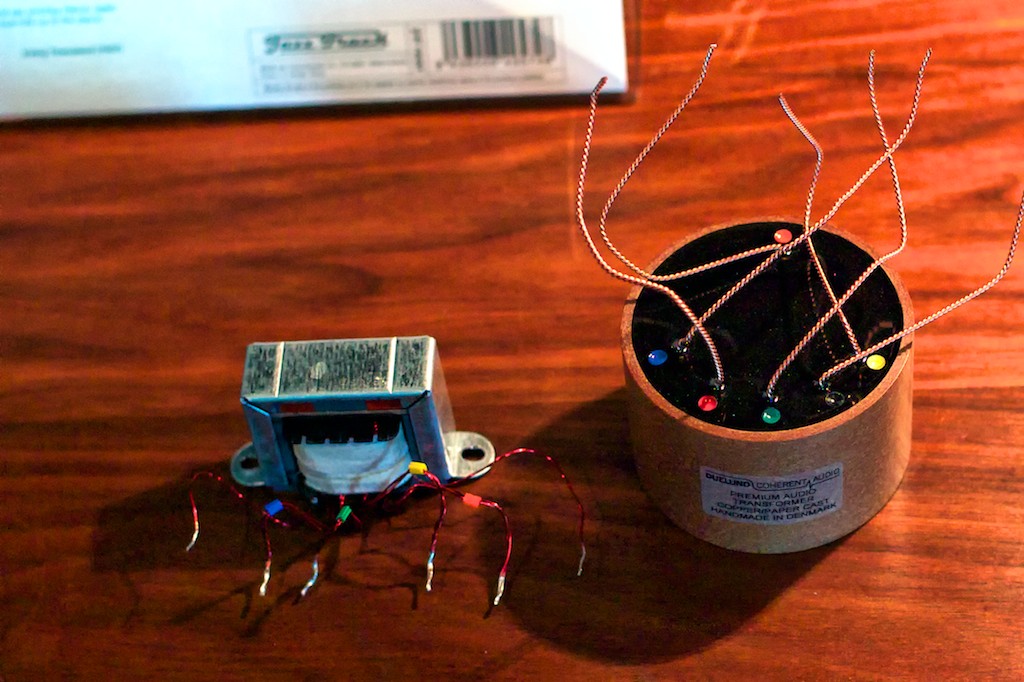
Stock Tannoy autotransformer (left), with the beautiful custom copper Duelund CAST autotransformer (right).
The performance of my Westminster Royal SE loudspeakers with the Duelund CAST copper crossovers completely blew me away, the transformation from the stock crossovers was astonishing!
As if that wasn't enough, Frederik did something extraordinary, he also sent along an absolutely incredible pair of all-silver Duelund CAST capacitors to try in the C1 positions of the high-frequency crossovers, as well as a pair of all-silver versions of his custom Duelund CAST autotransformers, which you can see in the photos below.
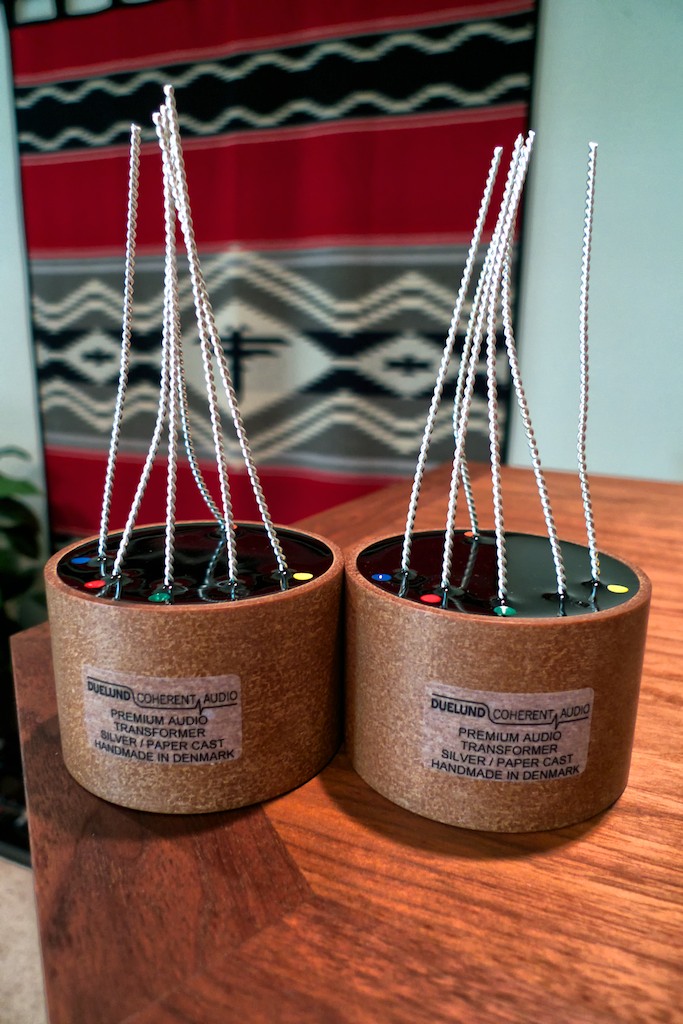
Custom silver Duelund CAST autotransformers for the high-frequency crossover circuits of the WRSE's.
I was absolutely dumbfounded by the huge increase in performance that the addition of the all-silver Duelund CAST capacitors & Duelund CAST autotransformers to the high-frequency circuits of the Duelund CAST crossovers brought about, it was as huge as the difference between the stock Tannoy crossovers and the Duelund CAST copper crossovers!
I was absolutely amazed that the addition of the all-silver Duelund CAST capacitors & Duelund CAST autotransformers to the already superb copper Duelund CAST crossovers could make such another enormous improvement in performance. It still boggles my mind when I think about the difference between the two!
I'm not the only one that's amazed by the performance of Duelund CAST components in crossovers, as there's also quite a number of loudspeaker designers who know about the huge performance increase Duelund CAST components can bring to their very finest loudspeaker designs, like Richard Vandersteen in the photo above, with Frederik.
Working with Frederik on the Duelund CAST crossovers for my Westminster Royal SE's was hugely illuminating for me. Thanks to Frederik, I began to grasp the principles of how crossovers work, and how capacitors, inductors, autotransformers, and resistors, are constructed, and how they function in the crossover circuits.
The mentoring and knowledge from working with Frederik on the Duelund-WRSE crossover project gave me the knowledge, understanding, and confidence to build crossovers from circuit diagrams.
Not only was it a wonderful experience working with Frederik on the Duelund-WRSE crossover project, but what I learned from Frederik gave me the confidence to build crossovers for my current vintage Altec-Lansing A5 Voice of the Theatre crossover project that I'm finishing up, as well as for the upcoming Stokowski Altec-Lansing A7 Voice of the Theatre crossover project that I will embark upon in 2017.
Then something else remarkable happened with Frederik, but this time in 2016.
I had been writing a lot in the last year about the now legendary vintage Western Electric WE16GA tinned-copper wire that Shirokazu Yazaki had introduced me to, and my wonderful results using it as speaker cables, internal wiring for the Duelund CAST crossovers, and internal wiring for my Westminster's.
Frederik recognized the performance potential of the tinned-copper conductors used in the vintage Western Electric WE16GA, and with a little help from yours truly in reverse engineering the WE16GA's tinned-copper conductors, Frederik developed the Duelund DCA16GA tinned-copper ‘tone wire’ that is a modern interpretation of the now extinct vintage Western Electric WE16GA tinned-copper wire.
Frederik went the vintage Western Electric WE16GA one better, and instead of the combination of plastic & fabric dielectric used in the WE16GA, Frederik applied the oil-soaked & baked cotton dielectric he used in his other premium Duelund cables to the tinned-copper conductors, and the resulting Duelund DCA16GA cable bettered even the legendary Western Electric.
Over the years I've heard premium cables made with conductors of gold, silver, copper, and now tinned-copper. I must say that tinned-copper is unique in its vivid and musical 'vintage tone', and while all conductors have their place for certain audio applications, it is the tinned-copper conductors that have risen above all others for what I value in musicality & sonics.
The Duelund DCA16GA with its tinned-copper conductors and with its oil-soaked & baked cotton dielectric, has extremely vivid tone color, superb dynamic response, melodic sophistication, harmonic complexity, live-like timbral complexity, spooky imaging presence, natural live-like level of resolution, generous portrayal of soundstage & soundspace, a presentation so breathtakingly musical, and with such high level of intensity of emotional engagement, that it makes for the finest speaker cables and interconnects that I have ever experienced, bar none.
Then in a complete surprise, with the lessons learned from using tinned-copper conductors in the DCA16GA cable, Frederik developed tinned-copper Duelund CAST capacitors, which have completely rewrote the book on what I expect from capacitor performance compared to any other capacitors I have used in my vintage McIntosh MX110Z tuner-preamplifier's circuits, and in the crossovers of my vintage Altec-Lansing A5 Voice of the Theatre crossovers I'm building.
I know how many of you (like me) have been thrilled with the performance of the DCA16GA, and I can't wait until all of you get a chance to hear what the new Duelund CAST tinned-copper capacitors are cable of when they are released in 2017, they are truly amazing, and have many of the same musical & sonic traits of the tinned-copper conductor DCA16GA.
I believe that the reintroduction of tinned-copper conductors in the Duelund DCA16GA cable, and in the Duelund CAST capacitors, may very well be ushering in a new audio age of unparalleled musicality & sonics, the likes of which enthusiast audio has never heard before.
Thank you, Frederik, for being an awesome mentor, and for all that I have learned from you during our Duelund-WRSE crossover project adventures, from the ongoing revelation of the Duelund DCA16GA cable, and now the amazing performance of the prototype Duelund CAST tinned-copper capacitors. I mean, "Wow!" - you're the best!
Jonathan Halpern, Tone Imports
Jonathan Halpern was the first person who introduced me to the wonders of vintage gear, way back in 2004, when he introduced me to the glories of the vintage Garrard 301 turntable, encouraged me to do a budget do-it-yourself Garrard 301 project, and even loaned me his vintage SME 3012 tonearm so I could get started!
That's Jonathan at the far left in the photo below, some years ago at the Salon Son & Image show.
I wrote up my Jonathan-inspired Garrard 301 project for Six Moons (1, 2, 3), and that project has gone viral over the years to inspire hundreds, if not thousands, of Garrard projects, which I think is really cool.
My do-it-yourself skills were pretty feeble back then, ok nonexistent, but with the help of Terry Cain (now deceased and greatly missed), we were able to build a beautiful home-brew plinth to mount my vintage Garrard 301 in. After we attached the tonearms fitted with Denon 103 phono cartridges, we played some music, and the result was really impressive!
I learned a valuable lesson from Jonathan about the musical value of vintage gear like the Garrard 301, the SME 3012 tonearm, and the Denon 103 phono cartridge. I was was able to get extremely satisfying musicality & sonics from that combination in a simple home-brew plinth, and all for a very modest investment.
It was really fun to travel down that vintage route with the Garrard 301, SME 3012 tonearm, Denon 103 phono cartridge, all installed on that home-brew wood plinth made by Terry Cain. That Garrard project was a real ear-opener!
There is something special about those vintage Garrard's and the way they vitalize the musical message, and as you know, I've never gotten over what I learned from that original Garrard project at the encouragement of Jonathan Halpern, and even today the mainstay of my primary home music system is a hot-rodded Garrard 301 turntable.
Jonathan was also the first person to encourage me to make home-brew interconnects using the venerable and very musical Switchcraft RCA's. To this day I use Switchcraft 3502AAU RCA's when I make my home-brew interconnects.
The Switchcraft 3502AAU interconnects are sized so they work well with the input spacing of all manner of vintage and modern electronics, they sound wonderful, and they're inexpensive. How can you beat that!
I also learned a lot about how to put together a simple and really musically satisfying home music system from Jonathan's example, using careful system setup with my Leben CS600 integrated amplifier and my Harbeth Super HL-5 loudspeakers.
Jonathan has won lots of show awards over the years for best sound, and he really knows what he's doing, and you too can put together a really fine music system by following his example (1, 2).
Don't just take my word for it, see these following reports of praise on the Stereophile website for Jonathan's show-winning combinations of gear:
Robert Deutsch’s 2008 Festival Son & Image show report on the Stereophile website here.
John Atkinson’s 2008 Festival Son & Image show report on the Stereophile website here.
Stephen Mejias’ 2009 Salon Son & Image show report on the Stereophile website here.
John Atkinson’s 2009 Salon Son & Image show report on the Stereophile website here.
Nearly ten years later, I still get immense satisfaction from my Leben CS600 and Harbeth HL5 system, it's a keeper!
I'd like to say a big "Thank you!" to Jonathan Halpern for being such a great mentor in introducing me to musical vintage gear like the Garrard 301 turntable and the SME 3012 tonearm; for his recommendation of the Switchcraft RCA's; and his impeccable advice on setting up a musically satisfying system on a budget.
Jonathan, you're a man of impeccable tastes, and you've made a significant contribution to my life in helping me understand what's important in the audio & musical arts.
A tip of my hat to you, Sir!
I sincerely want to thank Ron Barbee, Frederik Carøe, and Jonathan Halpern. I truly appreciate each of you, and your positive influence on my life and audio adventures! You're the best!
Ok, that's it for now, and there will be more to come.
As always, thanks for stopping by, and may the tone be with you!




